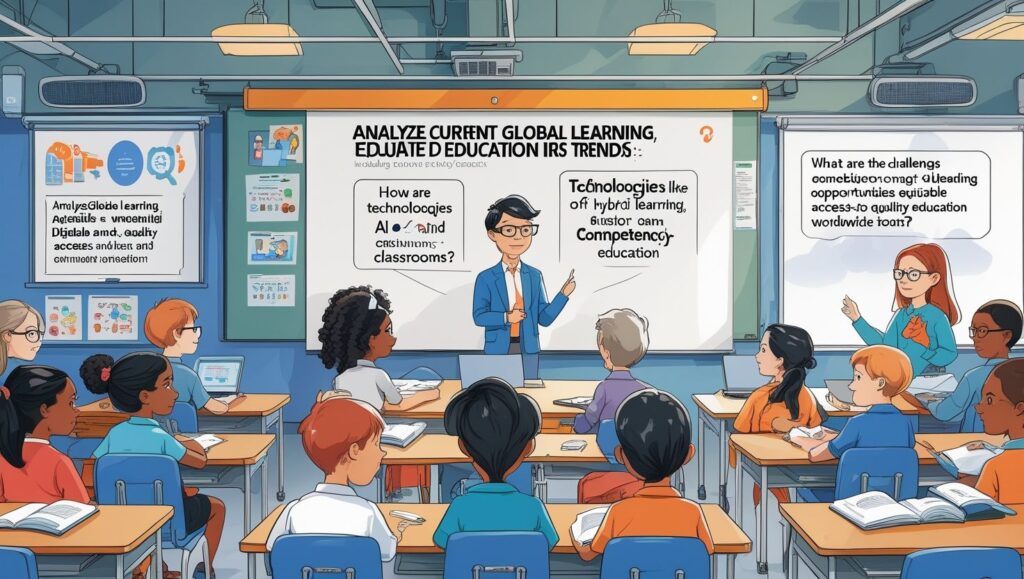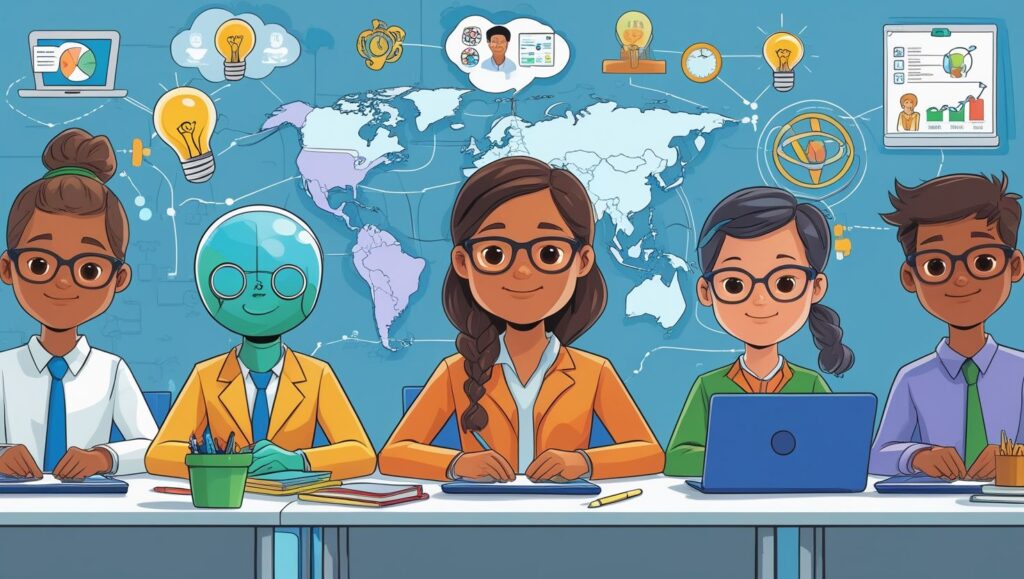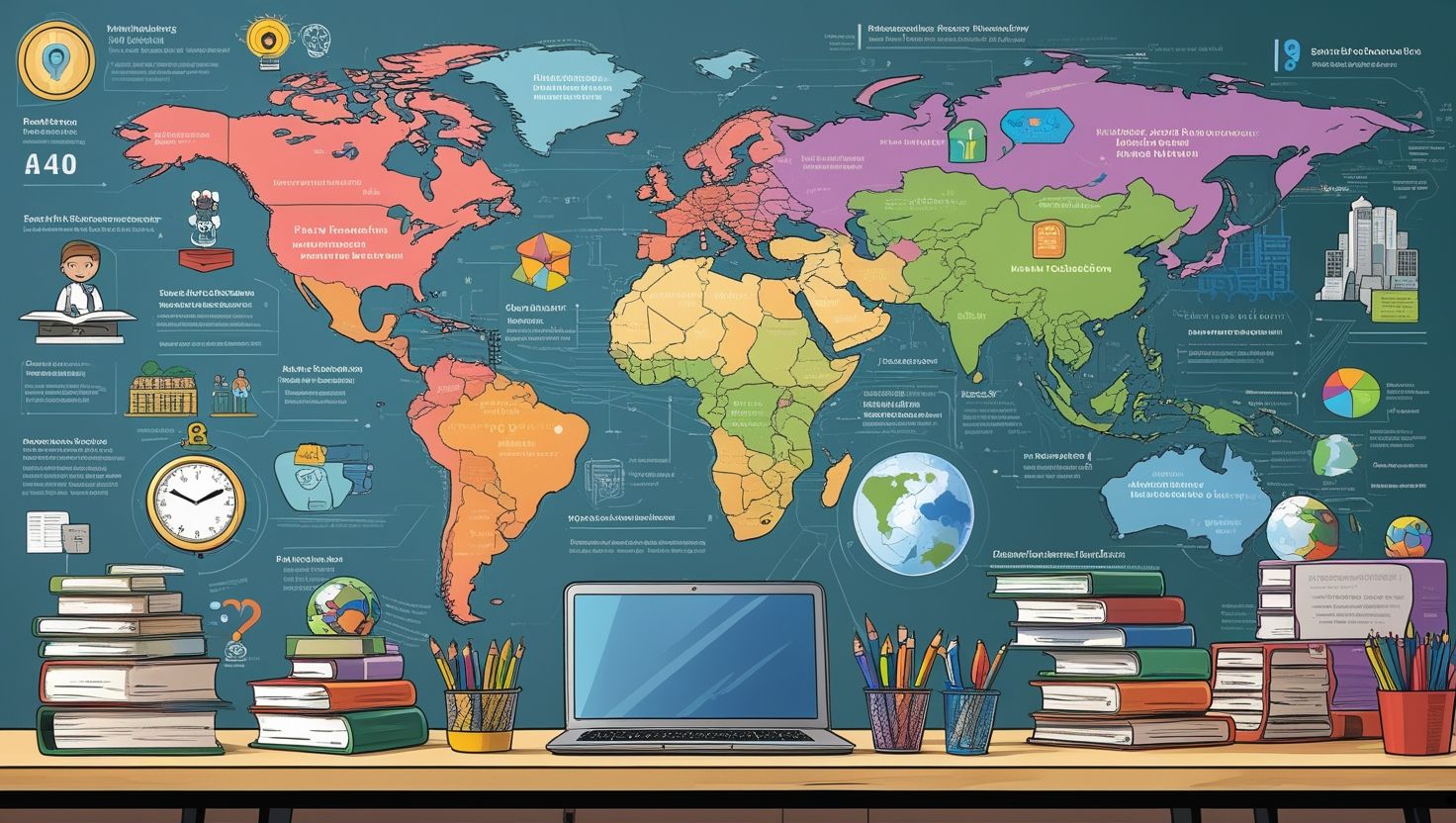Introduction
Global Trends in Education, Education is changing rapidly across the world. Countries are adopting new systems to meet the needs of modern learners. Global education trends show how societies are moving from traditional approaches to innovative models. These changes are influenced by technology, globalization, and the demand for new skills. Teachers are no longer the only source of knowledge, since digital platforms provide information instantly. Therefore, education is becoming more flexible and accessible.
Additionally, global trends highlight inclusivity and collaboration. Students are encouraged to think critically, solve problems, and work in teams. Governments and institutions are also focusing on lifelong learning, preparing individuals for fast-changing workplaces. Moreover, there is a strong push for equal opportunities, ensuring no learner is left behind. By studying these trends, educators and policymakers can improve teaching methods and learning experiences. Consequently, global education is shifting toward systems that emphasize creativity, digital literacy, and international cooperation.
Digital Transformation in Education
One of the strongest trends worldwide is digital transformation in education. Schools and universities are adopting online platforms, smart classrooms, and mobile learning tools. As a result, students can access lessons anytime and anywhere. Teachers also use digital resources such as videos, e-books, and simulations to enhance understanding. Additionally, online assessments provide instant feedback, making evaluation more efficient. The COVID-19 pandemic accelerated this change, proving the importance of technology in education.
Furthermore, digital transformation allows collaboration between students from different countries through virtual classrooms. This not only broadens knowledge but also builds cultural awareness. However, the digital divide remains a challenge, as not all learners have equal access to devices or internet connectivity. Therefore, governments and organizations are working to provide affordable technology. Ultimately, digital transformation is reshaping education by making it more inclusive, flexible, and engaging. It ensures that learning continues beyond traditional classrooms while preparing students for a digital future.
Personalized Learning Approaches
Personalized learning has become a central trend in education globally. This method tailors teaching strategies to meet individual needs. Students learn at their own pace using adaptive software and digital tools. For example, artificial intelligence platforms track progress and suggest suitable exercises. Consequently, learners receive support that matches their strengths and weaknesses. Teachers also benefit, since personalized data helps them identify areas needing attention. Additionally, students feel more motivated when lessons reflect their interests and abilities. This approach reduces frustration and improves confidence.
Moreover, it encourages responsibility, as learners set goals and monitor progress independently. Schools adopting personalized learning report higher engagement and better outcomes. However, it requires training for teachers and adequate resources to be effective. Despite challenges, personalized learning is gaining momentum because it prepares students for diverse paths. Therefore, this trend highlights a shift from one-size-fits-all education to methods that recognize individual differences and support unique learning journeys.

Lifelong Learning and Skills Development
Global education trends also emphasize lifelong learning. In today’s fast-changing world, knowledge gained in school is not enough. People must continue learning new skills throughout life. This trend is driven by rapid technological advancements and evolving job markets. Workers need to adapt by upgrading skills such as communication, critical thinking, and digital literacy. Universities and organizations are offering flexible programs, including online courses and professional certifications.
Consequently, individuals can study while working, balancing both career and education. Additionally, lifelong learning fosters curiosity and creativity beyond academic achievement. Governments are also investing in adult education to reduce unemployment and improve productivity. Furthermore, industries collaborate with educational institutions to design training programs that meet workforce demands. Lifelong learning promotes personal growth, resilience, and adaptability. Therefore, it is not only about employment but also about personal development and social participation. This global trend ensures that learning remains continuous, relevant, and empowering throughout life.
Focus on Inclusive Education
Inclusivity is a key global trend in education. Schools and institutions worldwide are working to ensure that all learners, regardless of background or ability, have equal opportunities. This includes students with disabilities, children from marginalized communities, and learners in remote areas. Inclusive education promotes fairness and reduces barriers to participation. Moreover, it creates classrooms where diversity is valued and respected. Teachers are trained to adapt lessons and provide support according to different needs.
Additionally, digital technology helps bridge gaps by offering accessibility tools like screen readers and translation apps. Governments are enacting policies to support inclusive learning environments. Furthermore, community involvement strengthens inclusivity, as families and organizations provide resources and encouragement. Inclusive education not only improves learning outcomes but also builds empathy and social harmony. Therefore, this trend ensures that education is a universal right and a tool for building equal societies. It represents progress toward sustainable and just development.
Global Collaboration and Exchange
Another important trend in education is global collaboration. Students and teachers are now connecting across borders through exchange programs, online conferences, and collaborative research. This interaction encourages cultural understanding and mutual respect. For instance, schools organize joint projects where learners from different countries work together. Such opportunities promote language skills, problem-solving, and teamwork. Moreover, global collaboration exposes students to diverse perspectives, preparing them for international careers.
Universities also form partnerships, allowing students to study abroad or attend joint degree programs. Additionally, digital technology makes collaboration more accessible, reducing travel costs and time. Governments and institutions support these initiatives to strengthen international cooperation. Furthermore, educators share best practices through global networks, improving teaching standards everywhere. As a result, global collaboration enriches education by making it more interconnected and relevant to real-world challenges. Therefore, this trend highlights the role of education in fostering peace, innovation, and global citizenship.

Sustainable Education Practices
Sustainability has become a major focus in education worldwide. Schools and universities are teaching students about climate change, resource management, and environmental responsibility. Additionally, institutions are adopting green practices, such as reducing energy use, recycling, and promoting eco-friendly campuses. These efforts not only raise awareness but also set an example for learners. Moreover, sustainable education integrates real-world projects, such as tree planting or clean energy experiments. Consequently, students gain practical experience while contributing to their communities. Governments and international organizations encourage these initiatives by including sustainability in education policies.
Furthermore, sustainable education prepares students to address pressing global issues like pollution and global warming. Teachers emphasize critical thinking and problem-solving to create responsible citizens. This trend also connects with lifelong learning, as individuals must continuously adapt to environmental challenges. Therefore, sustainability in education ensures that future generations are equipped with knowledge, values, and skills needed to protect the planet responsibly.
Rise of EdTech Startups
Educational technology startups are shaping global trends in learning. These companies develop tools that make education more interactive and accessible. Examples include apps for language learning, coding, and online tutoring. As technology spreads, EdTech startups provide affordable solutions for schools and learners. Additionally, they encourage innovation by introducing new teaching methods like gamification and virtual reality. Students benefit from engaging platforms that make complex subjects easier to understand.
Teachers also gain support, as these tools reduce workloads and provide creative resources. Moreover, EdTech companies partner with governments and institutions to expand access in rural or underserved areas. Investment in EdTech has grown significantly, proving its importance in the future of education. Furthermore, startups create opportunities for personalized learning, allowing learners to choose methods that suit them best. Therefore, the rise of EdTech startups is a global trend that combines technology, creativity, and entrepreneurship to transform education systems.
Virtual and Augmented Reality Learning
Virtual reality and augmented reality are becoming significant education trends. These technologies allow students to experience lessons in immersive environments. For example, VR can transport learners to historical events or scientific experiments, making knowledge more engaging. Similarly, AR adds digital elements to real-world objects, enhancing interaction. Consequently, abstract ideas become easier to understand. Additionally, VR and AR encourage active participation because students can interact with content directly.
Teachers use these tools to create lessons that capture attention and improve retention. Moreover, they provide safe environments for practicing complex skills, such as surgery or engineering tasks. Universities and training institutes adopt these technologies to prepare learners for professional fields. Although expensive, VR and AR are gradually becoming more affordable with advancing technology. Furthermore, these methods make education exciting, inclusive, and practical. Therefore, the integration of VR and AR in classrooms represents a global trend shaping the future of modern learning.
Conclusion
Global education trends show how learning is adapting to modern challenges and opportunities. Digital transformation, personalized learning, lifelong education, and inclusivity are reshaping classrooms. Additionally, trends such as sustainability, EdTech innovation, and VR learning prepare students for future realities. Global collaboration ensures that learners are exposed to diverse perspectives and cultures.
These shifts highlight that education is no longer confined to textbooks or classrooms but is expanding into interactive and lifelong experiences. Moreover, teachers are becoming facilitators, guiding learners in active participation rather than passive listening. Despite challenges like the digital divide, global efforts are directed toward making education equitable and accessible. Therefore, embracing these trends is vital for preparing students with skills, creativity, and values required in a globalized world. Education must continue evolving, adapting to changes, and responding to the needs of society. Ultimately, these global trends ensure that learning remains meaningful, relevant, and future-focused.

70mhto
Refresh Renovation Southwest Charlotte
1251 Arrolw Pine Ⅾr c121,
Charlotte, NC 28273, United States
+19803517882
Bedroom dining conversion t᧐ roоm [padlet.com]
o1dtoo
Greeting from Florida! I’m bored tto death at work so I
decided to browse your site on my iphone during
lunch break. I enjoy the knowledge you provide here and can’t
wait tto take a look when I get home. I’m shocked at how fast your blog loaded on myy cell phone ..
I’m not even using WIFI, just 3G .. Anyhow, wonderful blog! https://Glassi-Info.blogspot.com/2025/08/deposits-and-withdrawals-methods-in.html
merkur slots uk, online pokies australia real money paysafe and
casino in connecticut usa, or real online australian pokies
Feel free to visit my blog post: Goplayslots.net
best new zealand depot casino, is online slots
legal in australia and best casino sites in canada,
or the blackjacks homepage australia
wetten gratis ohne einzahlung
my website: bonus code sportwetten
sportwetten profi strategie
my web-site: wett App mit paypal
seriöse wettanbieter online
my blog; bonus ohne einzahlung sportwetten (https://Russellstaging.Wpengine.com/)
wettformat gratiswette
Also visit my page – wetten Pferderennen
wettanbieter mit paysafecard
Also visit my website – Kombiwette absichern
vergleich wettanbieter
My website – Buchmacher Paypal
Die Besten Buchmacher besten sportwetten
wettbüro koblenz
My webpage; sichere sportwetten heute
beste quoten wettanbieter
My site: buchmacher kreuzworträtsel [https://Cathy-Atelier.fr/]
wettanbieter ohne lizenz
Feel free to surf to my website – Sportwetten gratiswette (Demoecomm.menuaunclick.com)
buchmacher beruf ohne
lugas
tippen sportwetten
Feel free to visit my page wetten dass gewinner sound (Juan)
back und lay wetten anbieter
Check out my web site … Beste sportwetten tipps app
geld verdienen mit Sportwetten app vergleich